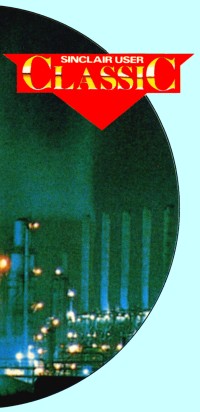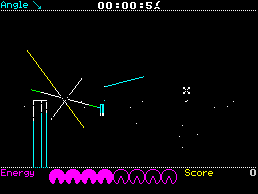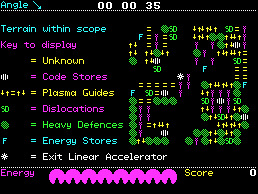
EVER SINCE I found the high-score table on Halls of the Things insulting me I've been confused by Design Design.
More recently we've seen Dark Star, a soft opera of galactic zapping, and the sequel, Forbidden Planet, is even harder. The cassette insert contains numerous obscure jokes but nothing about the game. The instructions on-screen helpfully advise you to collect all the bits of a code, and show you a picture of a hole, explaining that it's a hole.
I press the start button and find myself hurtling through space while tall thin towers and short wide platforms launch missiles at me. Score - 20. Time to get help.
Simon Bratell at Design Design wrote the game, so I talk to him. "It's best if you play it in the dark," he says.
After a long lunch I return to the fray and start again. The object of the game is to completely obliterate the galactic nasties whom you theoretically pulverised in Dark Star. Players of that game will find Forbidden Planet a lot easier to get used to. The bad guys have only one plans left, and you must explore the surface and find all the pieces of code. A map facility exists, but you only get to see a small part of the playing area at a time.
Because Bratell goes in for small targets and expansive black horizons, with little colour, everything moves around the screen at an extremely fast pace with no apparent loss of smoothness.
There are two playing techniques. Various squares on the planet map contain baddies in profusion, and those are static defences which fire missiles at you - depicted as a series of expanding squares or pieces of fractured light. Yes I know, it sounds confusing, but so is the game.

Not much on screen - but it certainly moves fast |
This is all accompanied by weird sound effects, buzzes, trills, clackings and explosions. You can choose the level of weirdness yourself. Those areas of the game are wild shoot-'em-ups, where you must shoot down the missiles. Some of the towers will only fire once and then pop down into the ground - go for the missile, not the tower.
The short platforms, on the other hand, fire several bursts, so eliminating the platform itself might be a better tactic there. As you gain skill, you may find it profitable to fly at a high speed through these defences, but you'll still have to take out a high proportion of them as they flash past.
The second element involves force fields which, as in Dark Star, have holes in them through which you must accurately fly. Some holes are dummy holes and will destroy some of your shields if you try to go through them. If you can see anything in a hole then it's safe to fly through.
There are also single-hole tunnels - a series of holes one after another. You don't have to work out which is safe, but once you are committed to going through them, they may channel you in an unwelcome direction. The whole playing area is a gigantic three-dimensional maze, with yellow holes flipping you into completely new parts of the planet to add confusion.

Luckily, both defences and the tunnel system remain reasonably predictable from game to game. Each game is different, but only because the sections of the map have been shuffled a little. Once you have worked out the correct sequences for particular groups of holes and defenders you can predict what will come next, and position yourself so as to cope with it better. Cope? Better? I'm not even convincing myself ...
Forbidden Planet is one of the most difficult space games I've ever played. It's massive, very complicated and utterly addictive. There is an extremely comprehensive set of key-define options, the usual manic high-score table, and even an IEEE joystick interface option.
But that's less than half the story. lf you succeed with Forbidden Planet, there's a bonus program, Spectacle 2, as with Dark Star. There are also a few surprises - a complete, updated version of the classic Halls of the Things thrown in free, and at least two other little games included. If, when loading the game, you press down key 0 and keep it down until the game has loaded, the computer decides that you want to play Space Invaders instead, and obligingly produces a perfectly respectable version of that old yawner. Get out of it by pressing F and you're in the main game.
Furthermore, a certain combination of number keys held down produces Whino Hunt, where you run around being chased by whinos while making for your goal. This trivial bit of nonsense is actually very useful when you're so shattered and tense from the difficulty of the main game that you need a break. A little whino wampaging loosens the fingers and takes the pwessuwe off.
Simon Bratell says there's even more fun and frolics hidden away on the surface of the planet. Buy this game - it's marvellous value for money, with Halls included as well, and a tremendous piece of zap programming to boot.
| Chris Bourne |
IN ITS DAY - 1983 to be precise - Halls of the Things was a tremendously advanced program. lt's an arcade adventure in which you choose from a series of levels of halls inhabited by the Things - small and repulsive blobs which hurtle around spraying fireballs and lightning bolts in all directions, but mainly yours. You are armed with an almost useless sword, plus a fireball and lightning spells.
The fireball homes in on monsters and is most effective, but drains your power. The lightning bounces around until it hits something, costs less power, but has a nasty habit of coming back in your direction if it misses. Bows and arrows were available in the original, but we couldn't find them in the new version - which is presented as a surprise bonus without much in the way of instructions.
Around the halls are piles of treasure, some of which can be collected for points. Others turn into Things when you get close. There are also potions which repair your energy levels,and rather rare rings which are what you are supposed to be collecting.
It's great fun, and I still play the original at home sometirnes, though I know a minority of critics were not so inrpressed. You either love it or hate it; it was the first game of its type, and has been very influential on the development of arcade-adventures since.
For those familiar with the original, the new version dispenses with the whole status display in favour of providing added options. Those include tougher monsters, strange mazes, or both together. Joystick options are included, and user-definable keys, though this is not a good game to play with joysticks as many keys are required for different spells, picking up things and so on.
It's a great bonus anyway, and if you didn't catch it first time round, it makes Forbidden Planet an almost insane bargain at the price. No collection of software 'classics' is complete without it.